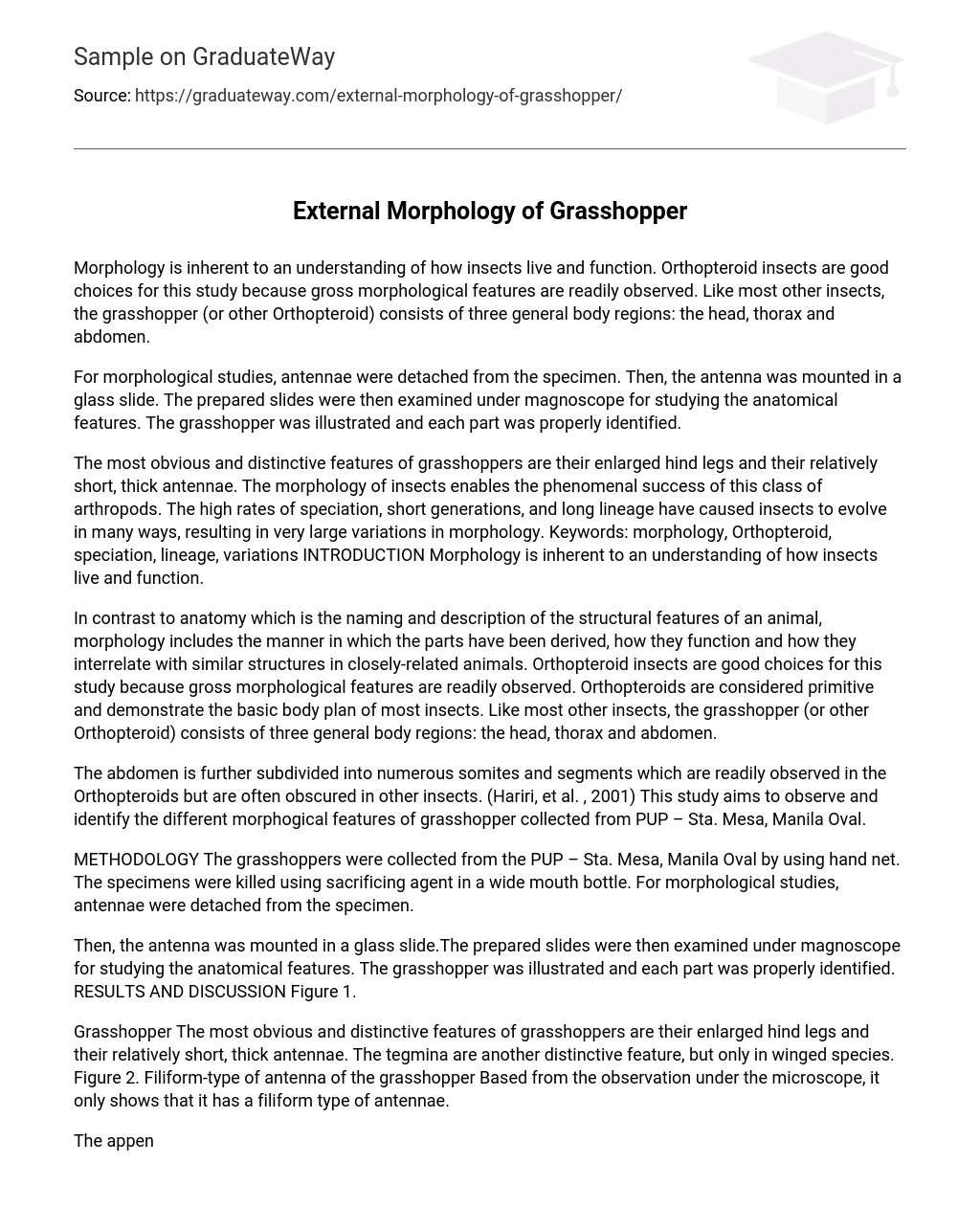It is crucial to understand the morphology of insects in order to grasp their life and functioning. Orthopteroid insects, such as grasshoppers, offer a great opportunity for studying morphology due to their easily observable gross morphological characteristics. These Orthopteroids possess three primary body regions: the head, thorax, and abdomen.
The antennae of the specimen were delicately taken off and placed on a glass slide for morphological examinations. Subsequently, the glass slides were scrutinized with a magnoscope to explore the anatomical attributes of the antennae. Elaborate illustrations of the grasshopper were produced, precisely specifying each individual component.
The distinguishing and evident characteristics of grasshoppers are their enlarged hind legs and relatively short, thick antennae. Insects, including grasshoppers, have undergone diverse adaptations in response to their morphology, which contributes to their remarkable success as a class of arthropods. The notable rates of speciation, rapid generations, and extensive lineage have resulted in significant morphological variations among insects. Hence, a comprehensive understanding of how insects live and function necessitates an appreciation for their morphology. Keywords: morphology, Orthopteroid, speciation, lineage, variations.
The study of Morphology is concerned with the origins, functions, and interrelationships of an animal’s structural features as well as similar structures in closely-related animals. Examining Orthopteroid insects provides a valuable opportunity to investigate these aspects due to their easily observable gross morphological characteristics. Orthopteroids are considered primitive and represent the basic body plan that most insects share. Grasshoppers (and other Orthopteroids) have three primary body regions: the head, thorax, and abdomen.
The aim of this study is to examine and categorize the different physical features of grasshoppers obtained from PUP – Sta. Mesa, Manila Oval. In Orthopteroids, the abdomen can be clearly separated into distinct somites and segments, allowing for easy identification. Nevertheless, in other insects, it may pose a challenge to recognize these divisions (Hariri, et al., 2001).
Grasshoppers were collected from PUP – Sta. Mesa, Manila Oval using a hand net. The specimens were killed in a wide mouth bottle using a sacrificing agent. For morphological studies, the antennae were detached from each specimen.
Then, the antenna was placed on a glass slide. The slides that were prepared were then observed using a magnoscope to study the anatomical characteristics. The grasshopper was depicted and each individual part was correctly labeled.
Grasshoppers have enlarged hind legs and relatively short, thick antennae. Winged species also have distinctive tegmina. The observation under the microscope confirms that grasshoppers have a filiform type of antennae.
The grasshopper has two appendages on its head – the antennae and mouthparts. The antennae are responsible for sensing, while the mouthparts include the mandible and maxilla. The maxilla is located behind the mandibles and is used for cutting and holding food.
Moving down to the thoracic region, the grasshopper has wings and legs. The forewings have a leathery appearance and protect the hind wings. The legs have different functions – the first two pairs are for walking, while the last two pairs enable jumping.
Male grasshoppers have distinct sexual characteristics compared to females. They have a thinner tail, smaller size, rounded abdomen that dips into a subtle curve before tapering at a slightly raised angle.
Female grasshoppers have a larger tail, size, and straight abdomen compared to males. Their legs are also slightly longer. The success of insects as arthropods stems from their morphology. The immense quantity and diversity of insect taxa are accompanied by a wide range of modifications in their body structure. Insects have evolved in numerous ways due to high speciation rates, short generations, and long lineages, resulting in considerable variations in morphology.
These alterations enable insects to inhabit virtually every ecological niche, exploit a remarkable range of food sources, and exhibit diverse lifestyles. Following this descriptive investigation, it is suggested that grasshoppers be utilized as a suitable option for this study due to their easily observable gross morphological characteristics. Additionally, organisms encountered within the observed area must be further described anatomically and identified in order to compile and reach a precise conclusion regarding their physical adaptations and the impact of these environmental conditions on them.





